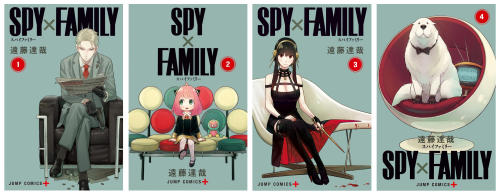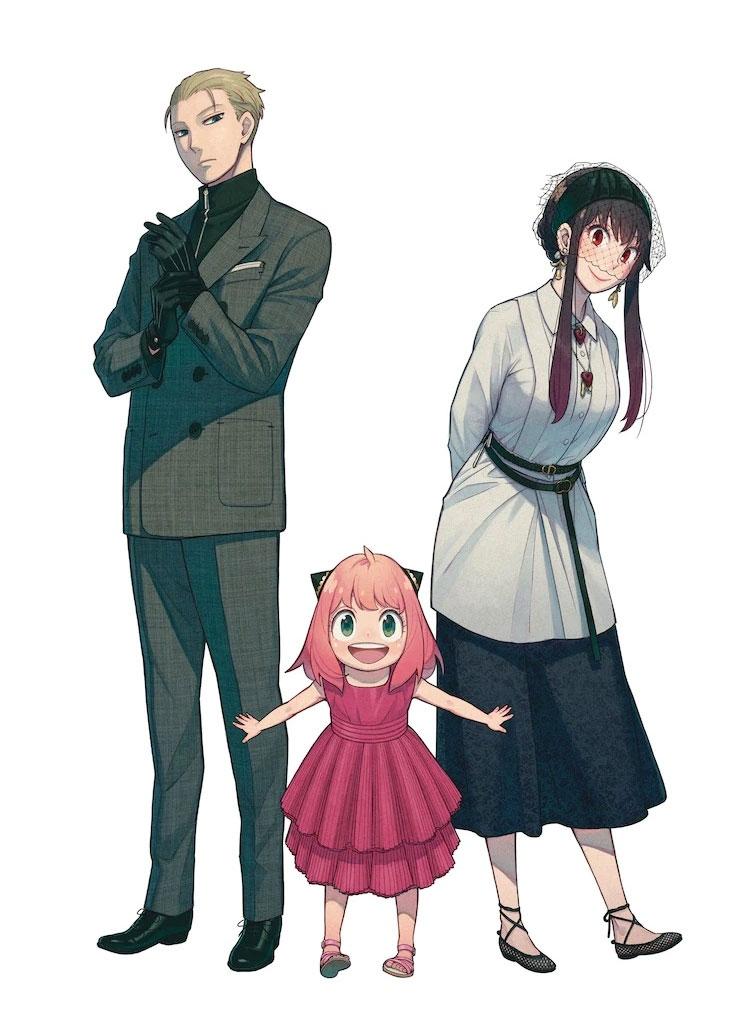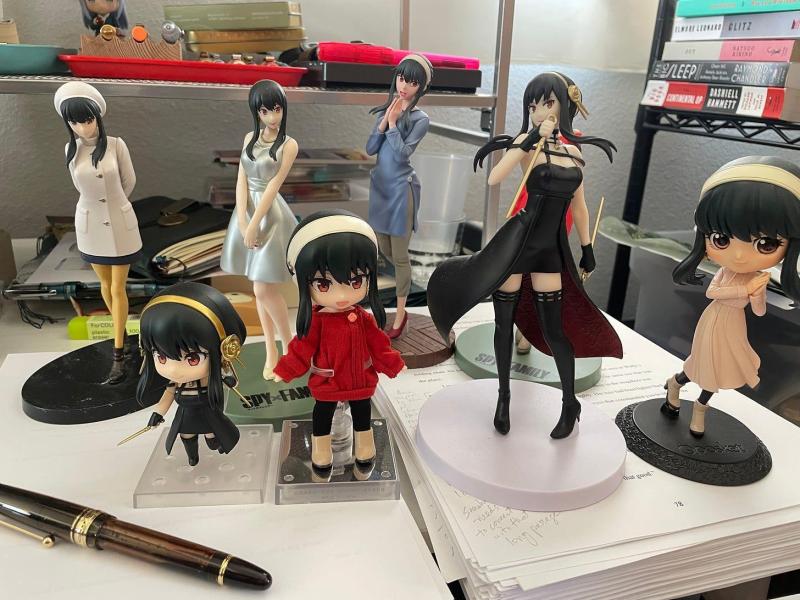
The author with Yor Forger in her red sweater dress at Waku Waku Park, Osaka in March 2024
Cold War Chic: Spy X Family Pushes all the Right Aesthetic Buttons
I love cartoons. I loved them as a kid, and I still love them as a grown, tax-paying contributor to society.
I started with Saturday morning fare of my childhood, most of which were older cartoons in syndication: Warner Brothers’ Bugs Bunny Road Runner Hour (the humor was surprisingly sophisticated and taught me the value of devices like parody and irony) and Hanna-Barbera fare like The Flintstones and The Jetsons, which were really thinly-disguised golden age television sitcoms like The Honeymooners and Make Room for Daddy in wonderful, newspaper-funnies brushstroke style.
Beyond the thoughtful writing and the comedic timing, what left the biggest impression on the already impressionable kid that I was had to be the style of the illustrations. They were indicative of the age that produced them, from the brush lines to the women‘s exaggerated hairstyles and the hats and suits worn by the men. Even Fred Flintstone and Barney Rubble in their “caveman” attire looked quintessentially suburban.
Then, as I got a little older, cartoons became stylistically revolting as 1970s “creatives” settled into their own stomach-turning oeuvre. Scooby-Doo and the characters’ bell-bottoms.
Formulaic “limited animation” Lou Scheimer-Norm Prescott schlock with reused instrumental soundtracks. There was even a cartoon inspired by the paragon of seventies tacky, Evel Knievel (It was called Devlin). It was the age of candy-sweet, artificially dyed breakfast cereal, plastic toys muscling out die-cast metal for consumer dollars and the first appearance of Civil War General sideburns since the Civil War.
Cheaply-made cartoons like the 1970s Devlin are hardly remembered today
It all made me seek out the stuff in syndication because they just “looked” better.
I wouldn’t find another cartoon that jived with my own aesthetic sensibility until decades later, and it came out of Japan.
It should come as no surprise that as a Japanese American from Hawai‘i, I got into manga and anime. My friends and I were able to get a hold of Shonen Jump in high school, and in college and after were able to get a hold of Beta and VHS tapes of anime without subtitles, which made it tough to understand, but who cares when the illustrated girls were cute? It started with Takahashi Rumiko’s Urusei Yatsura and Toriyama Akira’s Dr. Slump in the mid-1980s when we transitioned from high school to college.
I was to consume various Japanese manga and anime over the years, enjoying the narrative style and the subtle conveying of emotion and character interaction through animation which was lacking in American production (I’m looking at you, Disney) when a couple of years ago, I discovered a production that sent a thrill through me aesthetically for the first time in a very long time. My friend, the Professor, recommended an anime called Spy x Family.
Opening theme song animation of Spy x Family
Spy x Family (or just “Spy Family,” as the “x” is apparently a visual device and not really part of the title) follows the exploits of a spy, code name: Twilight, who adopts the pseudonym of Loid Forger (pun intended) on a mission for his employer, the government of a fictitious, probably European nation called Westalis (read: West Germany). He is embedded in the neighboring enemy nation of Ostania (read: East Germany), with a mission to get close to a target official by posing as the parent of a student at an elite prep school. Loid Forger needs a child and wife to complete his cover. For a child, he finds Anya at an orphanage, who can read minds, and for a wife, he enters into a “marriage” with Yor Briar, a civil servant who is an assassin by night. Loid, Anya and Yor keep their true identities a secret from each other while living under the same roof, a made-up family that gradually becomes a real one.
There are many reasons to love this show. It is well-written, full of humor both slapstick and sophisticated, with many pop culture and period references. The characters are interesting and sympathetic and have convincing arcs as the series progresses. It’s also very well animated.
My main reasons for loving this show are, of course, aesthetic. For a writer stylistically obsessed with the mid-20th century, this show hits all the right notes. The setting is imaginary, a couple of fictitious western countries with piss-poor relations with each other in an era which is probably the early 1960s, though with elements of the two decades before and the decade after: Dr. No, generously incorporated with North by Northwest and a dash of The Mod Squad.
The clothing of the main characters is reminiscent of early 1960s fashion in America at about the time of the Kennedy administration (though the manga and anime are ostensibly set in a “European” city). Loid Forger sports a green suit that fits like a Brooks Brothers Sack Suit No. 1 (though most images show the jacket is darted, but hey, you can’t have everything) with black oxfords and a short-brimmed trilby hat. Anya Forger wears pinafores and smock dresses when not in her Eden College uniform, which is also true to the period. Yor Forger’s dramatic “Thorn Princess” assassin’s evening dress has period Balenciaga elements, while her street clothes are Chanel-inspired and her casual red sweater dress is worn with black tights and ankle boots, putting her sartorially later in the 1960s. I could watch the series for the clothes alone.
The characters of Spy X Family have a distinct 1960s fashion flair
Our stylish fake family is dropped into a set that looks like a cross between Western Europe in the Cold War and New York City in Breakfast at Tiffany’s. The backgrounds are full of brownstones and picturesque parks and the streets of their home city of Berlint are full of 1960s European cars, from period Mercedes-Benz to Volkswagen to the East German-made Trabant.
The soundtrack accompanying the action and dialogue in the episode is mostly jazz-inspired, mixed in with comical riffs reminiscent of 1960s Hanna-Barbera gag pieces from shows featuring Yogi Bear, Huckleberry Hound and, of course, The Flintstones. The opening and closing credits have the panache of the Albert R. Broccoli James Bond 007 films. I especially like the closing credits of the first season, which incorporates Mondrian-inspired elements. This is a clinic on the best use of animation as a medium.
The source material for the anime is, of course, a manga, which is still ongoing as of this writing. The manga’s creator, Tatsuya Endo, has imbued it with period stylistic references. Endo has acknowledged in interviews that the era that inspired Spy x Family is the 1960s. One of the first visual impressions to hit you right away when reading the manga is in your face before you open the book: the first few covers feature a character on an era chair, classic mid-century designs, mostly from the early 1960s.

.
The period chairs of the Spy x Family covers (l to r): Loid Forger on the Le Corbusier LC2 Lounge Chair, Anya Forger on the George Nelson Marshmallow Sofa, Yor Forger on the Eames La Chaise, Bond Forger on Eero Aarnio Ball Chair (images from Wikipedia)
And really, how cool is this? A match made in retro mid-century style heaven—Endo collaborated with Dior in 2021, rendering the Forgers in their Spring/Summer collection:

Source: Crunchyroll
Watching Spy x Family episodes is one of my favorite breaks from composing new chapters in my novels because the images really keep my head in the period. They make me long for a time I never lived through in the place that I live in. Once upon a time, men wore hats and ties and women donned pearls and white gloves, even here in sweltering Honolulu. When the early 1960s came to an end, so did dressing well. Hawai‘i gets the credit (I say the blame) for starting the nationwide phenomenon known as “Casual Friday,” which some popular culture experts say grew out of something we call “Aloha Friday”. This Aloha Friday was originally a marketing ploy involving wearing aloha attire to work for the tourists to see. Whether this was true or not, it was all downhill after that. Casual is now the norm, and not just in Hawai‘i. All across the United States, we’ve turned into slobs. They’re wearing track suits into board meetings on Wall Street, for crying out loud.
Why can’t we all dress like Spy x Family?
The early 1960s aesthetic will always be associated with popular culture perceptions of spies as tales of espionage took root during the period. It was the time of John le Carre, of Sean Connery as James Bond. The real-life Cold War fueled the imaginations of creators worldwide. And all those people wore better looking clothes, drove better looking cars and worked in better looking buildings than we do today. It was the era of shoulder holsters and cigarette holders, when martinis were for lunch and everyone knew what a cocktail dress was supposed to look like. And wouldn’t you know? The best contemporary depiction of this age is in a cartoon. Endo’s Spy x Family and the Wit Studio/CloverWorks anime pull off the greatest feat in historical fiction: immersing the consumer in the period.
Even if the period never really existed.

.
Part of the author’s collection of Yor Forger figures.
_______________________________________
Scott Kikkawa is a fourth generation Japanese American raised in Hawai'i. Currently a federal law enforcement officer, the New York University alumnus is the author of three noir detective novels set in postwar Honolulu—Kona Winds (2019), Red Dirt (2021), and Char Siu (2023) and numerous other short stories. He can be contacted at scottkikkawa@gmail.com
Discussion Questions
- In what era and place is Spy × Family set, and why does it feel like the 1960s?
- How do the costumes and settings (like cars, buildings, and background design) help make the fictional world feel realistic and stylish?
- Why might combining retro elements—from European Cold War era with a hint of Breakfast at Tiffany’s—appeal to modern audiences?
- Spy × Family uses jazz-inspired music and visual cues from James Bond films. Can you think of another show or movie that uses music or style to connect emotionally to its audience?
- Why do you think the author longs for “a time I never lived through” after watching Spy × Family? What does this reveal about how style and nostalgia can influence us?

Add new comment